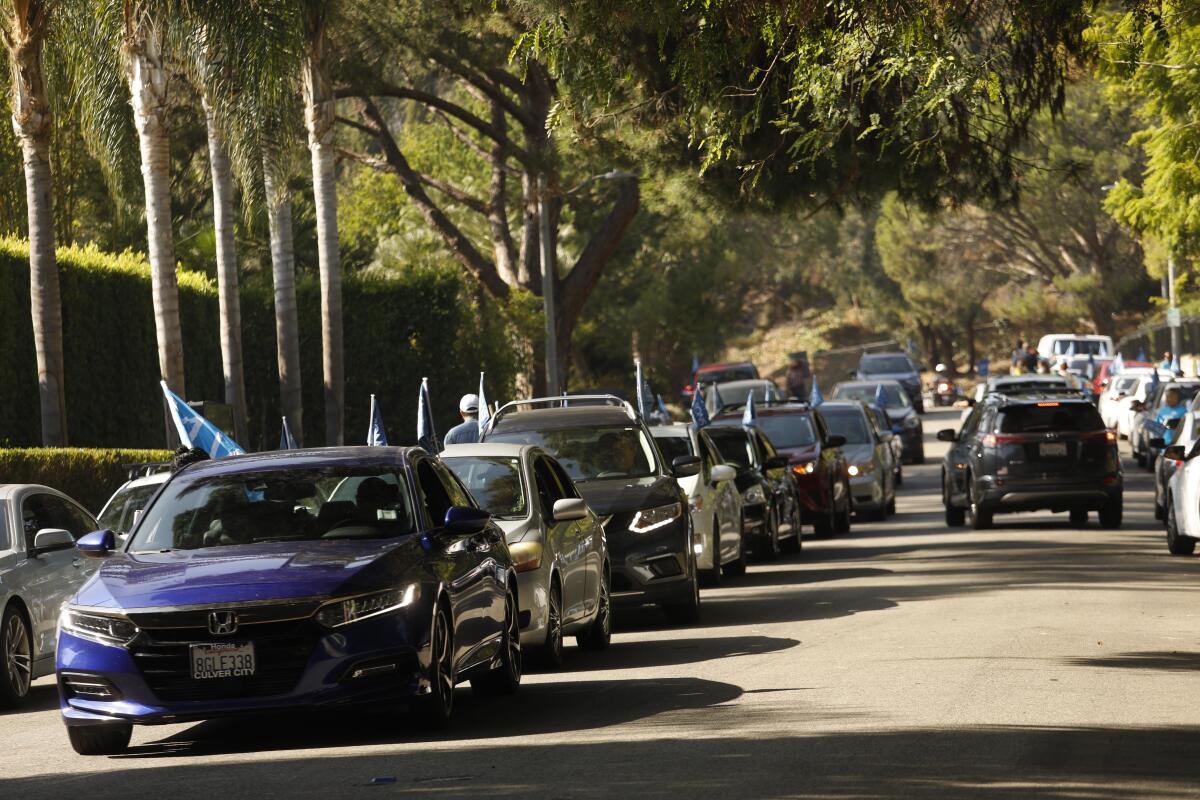Uber hoped to celebrate a big payday. Instead, a sinking stock and more protests

- Share via
Around 50 cars with Uber and Lyft logos plastered on their windshields wound through the palm tree-lined streets of Beverly Hills, down Rodeo Drive and into the quiet hills, past palatial homes.
They stopped in front of the $71-million residence of Garrett Camp, co-founder of Uber, and the drivers piled out.
“Uber, Uber, you can’t hide, we can see your greedy side,” they chanted.
Wednesday marked the end of the lockup period barring insiders from trading Uber shares — and it could have marked a moment of exuberance for the company’s employees, investors and founders, like Camp. Instead, the ride-hailing firm commemorated the day with a record-low stock price and fresh protests from Beverly Hills to Atherton.
When all goes according to plan for a high-flying start-up, the end of a lockup period is the moment paper millionaires can turn into real millionaires. But the 180 days since Uber’s IPO haven’t brought the company much good news, nor did Wednesday’s potential payday.
Lackluster quarterly results in Monday’s earnings report did little to prevent early investors from flooding the market with shares the moment they could.
Amid a sell-off that made it one of the most actively traded stocks in the U.S. by value, according to Bloomberg, Uber hit an all-time low of $25.58. The business news outlet reported that one block trade involved 7.75 million shares at $26.02 apiece, and a separate sale of 2 million shares at $26.90 apiece — both below the previous day’s close of $28.02. It’s unclear which shareholders were behind those major sales.
Shares are down about 40% from Uber’s initial public offering price of $45. Uber closed Wednesday at $26.94.
Uber declined to comment on the protests and referred questions about the end of the lockup period to a transcript of its quarterly earnings call with analysts Monday. “Obviously there is a lot of supply that’s going to hit the marketplace and we don’t know what’s going to really happen,” Chief Financial Officer Nelson Chai said on the call, “but you can rest assured we’ve taken whatever steps we can to have the dialog that we need to with most of the parties.”
This year has been a flop for many tech companies making their Wall Street debut. Highly anticipated initial public offerings from Uber and Lyft tanked right out of the gate, and WeWork crashed and burned before it even reach an IPO, suggesting that high private market valuations are no guarantee of public market success.
In its early years, Uber grew rapidly, rendering taxis obsolete with its app-enabled ride service. Fueled by billions of dollars of venture capital, brash co-founder and former Chief Executive Travis Kalanick wasn’t shy about his ambition to upend the world of transportation entirely.
Current Chief Executive Dara Khosrowshahi has indicated he’s trying to rein in the company’s spending, as he did its out-of-control culture. Since Uber went public, Khosrowshahi has made significant cuts to the company’s workforce, laying off about 400 employees in the marketing department in July and another 400 in September.
“We are not doing this for Wall Street,” Khosrowshahi wrote in an email to staff in September. “We are doing this for Uber.”
Despite the bumpy start, some early investors remain confident in Uber’s trajectory, including Shawn Carolan of Menlo Ventures, who tweeted that it was an “easy choice” to hold.
Investor Jason Calacanis told The Times he doesn’t plan to sell anytime soon, then shared an earlier tweet noting an uptick in Uber’s rides and deliveries and a downturn in the company’s losses, accompanied by a short “Star Wars” clip showing Luke Skywalker patiently waiting until the last moment to destroy the Death Star. Lowercase Capital, a fund founded by Chris Sacca, did not sell its shares and does not have any near term plans to sell, according to a source familiar.
“Wait for it,” he urged Khosrowshahi on Twitter. “Stay on target.”
Others, including Bradley Tusk, posted publicly about their desire to offload shares. Tusk said he didn’t sell at a loss, but was surprised to see shares trading for prices below the $33 per share that Softbank paid when it became the majority shareholder in Uber in January 2018.
“If you’re buying Uber, you believe in the future of the company — because the present of the company is a disaster,” Tusk said. “You have to believe in their ability to do great things. You have to believe they can execute it.”
A spokesperson declined to comment. Camp did not respond to requests for comment. Benchmark Capital, which previously sold about 15% of its holdings in Uber to Softbank and other buyers for $900 million in January 2018, did not respond to requests for comment.
While a company’s initial public offering is a landmark moment, regulations require certain stockholders to wait six months after an IPO to actually unload their shares. Traditionally, that has made the end of the lockup period the real red-letter day for employees — the day when the life-changing, buy-a-house-and-a-boat money came through.
But two trends in the tech world have dampened the excitement.
First, there’s a chance that some employees have already partially cashed out. There’s now a thriving secondary market for stock options, especially at big companies like Uber, which allow employees to sell shares while a company is still private.
But the industry trend toward delaying IPOs by raising larger and larger rounds of private capital has had a more significant effect. Employees take payment in stock based on the hope that a company’s stock will go up once it’s in the public market. But an analysis by EquityZen, one of the companies that run a marketplace for trading employee stock in start-ups, showed that the price of Uber stock had remained essentially flat from 2016 through the IPO, even as the company hoovered up larger and larger piles of investment.
In fact, Uber’s stock price today is more than 10% lower than in December 2014, according to the report, meaning that even five-year employees of the company may not wind up taking home as much as they anticipated.
It’s just another blow for a company taking hits from all sides.
Along with pressure from investors, Uber’s entire business model in its home state of California is in question after Gov. Gavin Newsom signed sweeping new employment rules into law in September.
California businesses will face more limits on their use of independent contractors, upon which Uber’s business is built. The San Francisco company classifies its thousands of drivers as contractors rather than employees, which saves it money and helped enable its rapid expansion.
Under the law, drivers could qualify as employees and thus be granted perks such as health insurance, workers compensation and minimum wage requirements. Uber and other gig-economy companies have pledged $90 million to fight the law with a ballot initiative, saying its workers prefer the flexibility of nontraditional employment.
Workplace issues were top of mind for the 30-some drivers who marched down a tree-lined cul-de-sac Wednesday in Atherton, an affluent Bay Area suburb popular among tech types. Their target was the home of Benchmark Capital partner and former Uber board member Bill Gurley.
Holding signs that read, “Investors live in mansions, drivers live in cars,” they rallied under the watch of Atherton police, who arrived with multiple cars including a K-9 unit.
Edan Alva, a ride-hailing driver for five years, said he helped create a list of investors who stood to profit the most from selling Uber shares. (Gurley did not respond to requests for comment and it is unclear if Benchmark opted to sell shares Wednesday.)
Alva said the goal was to attempt to embarrass Gurley and other major investors in front of their neighbors and communities for enabling Uber to prioritize profit above the treatment of workers.
“Athletes when they cheat, we take away their prizes,” Alva said. “Parents that try to get their kids into university and try to bribe the administrators, they get arrested. We shame them. The purpose of being here is to … shame them. To change the conversation across society from perceiving them as successful.”
Times staff writer Sam Dean contributed to this report.
More to Read
Inside the business of entertainment
The Wide Shot brings you news, analysis and insights on everything from streaming wars to production — and what it all means for the future.
You may occasionally receive promotional content from the Los Angeles Times.












